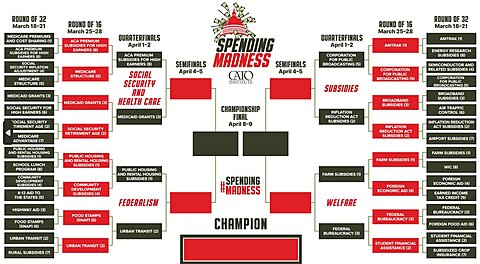There are eight federal programs remaining in Spending Madness 2024. These are high‐priority spending cuts for Congress to consider, according to our crowdsourced tournament results so far.
Please vote today in the quarterfinals, and then we’ll move to the next round on April 4.
The failures of the eight remaining programs are summarized when you click the pictures here. One common failing of government programs is stagnancy. While market economies are always adapting and improving, the bureaucratic government falls behind. Outdated programs linger for decades consuming taxpayer resources and undermining the economy.
The Corporation for Public Broadcasting was launched in the 1960s but adds little value in today’s expansive media environment where vast educational content is available on YouTube. Even more outdated are farm subsidies, which were launched in the 1930s when many farmers were poor. Today, farmers are much wealthier than other people, and farm subsidies mainly go to large corporate‐style operations.
And there is public housing. What do you notice in these photos (below) of a project in Alexandria, Virginia? When you walk around it, you see that all 13 buildings are the same, and they are unchanged in the seven decades since the government opened them in 1947. It apparently never occurred to the government managers to plant any trees, bushes, or flowers.
Because people in public housing are not owners, no one has put in bay windows, added an addition, painted their homes, built a deck, or made any other normal improvement. I wonder where tenants are even allowed to plant anything.
Government programs and policies tend to be stagnant and uniform. Many programs have outlived any usefulness their original supporters envisioned. Congress should end subsidies for activities—such as housing, broadcasting, and farming—that markets can tackle with diverse and innovative approaches.
Background. The photos are the Samuel Madden Homes built in an area called The Hump. The construction was part of Big Government “slum clearing” efforts in the mid‐20 century, which used eminent domain and federal dollars. As one history notes, Alexandria “began a program of ‘slum’ clearance in 1939 and two years later condemned and demolished homes in two mixed‐race neighborhoods, The Berg and The Hump, sending Black residents into substandard, segregated public housing.” The Samuel Madden Homes are finally being redeveloped after 77 years, and hopefully some lessons have been learned.

